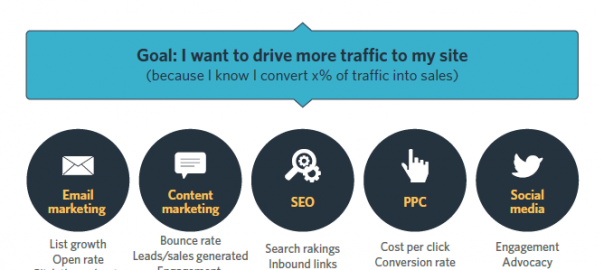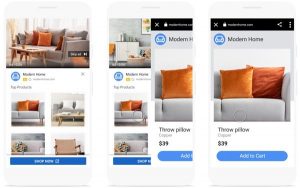
During our recent ‘Growing your digital marketing agency: solving the measurement puzzle’ webinar it became very clear that, aside from having a clear goal, a healthy dose of reality also helps. You need to ask yourself, which channels can you, realistically, manage? What resources are you working with? And do you you have the capacity and ability to examine in detail?
With this in mind, our speakers created a simple, goal-driven measurement framework, starting with a single objective at the top. They then set out the marketing channels a client might plan to engage in — such as email marketing, social media, SEO or PPC — and under this they identified the key metrics for each channel. As mentioned above, the criteria for these was that you should have the capacity to measure the outcomes and ultimately, the impact on the business with some degree of accuracy.

Sean Clark, Search and Social Media Marketing expert advises:
“Once you’ve got that little pyramid with your goal at the top and you’ve got your email strategy, search strategy, content strategy and social strategy etc. — then you can start measuring.”
Creating a measurement strategy for an SME
Given that the vast majority of businesses are SMEs, our panel felt we ought to address the question of how to create a realistic measurement strategy without overburdening the client. Tamsin Fox-Davies explains how she and Constant Contact advise their SME customers to approach measurement. She recommends starting with achievement of the end goal, such as a confirmed sale or lead:
“Once you’ve made a sale, you just work backwards from there. What did your customer do [in relation to your company] before they gave you money? And what did they do before that? And before that. It’s really, really simple, but for a lot of small businesses, they haven’t thought about it this way.”
Do different types of clients need different measurement strategies?
In recent years, we’re seeing B2B marketing agencies and consultancies emerging, offering specialist services to business-facing organisations. But, what’s the difference from a measurement perspective?
Working backwards enables SMEs, who are often pressed for time, to identify the individual paths their customers take and discover ways of measuring them. This meets all the recommendations we’ve made previously (focus on one metric, start with a goal etc.), but in a way that is immediately actionable and can be done on a path-by-path basis over time. Luke Brynley-Jones from Our Social Times provides some insights on this:
“We have B2B clients and we have B2C clients and we have separate teams who manage them. They are very different in that the B2B clients are after leads and sales, primarily, with a bit of awareness to go with it, whereas the B2C are very focused on awareness and engagement with their target audience”.
Creating an end-to-end measurement process
Without a doubt, it’s important to measure your marketing activities, but without knowing the sales/leads you’re developing, you can’t really evaluate which marketing activities are working best. Tamara Baranova suggested:
“If you or your clients don’t run an e-commerce business [which will most likely track your end-to-end sales process] but do have a book-keeping system, this might give you some valuable information such as your sales growth, cost per lead, cost per customer, what sort of products are selling best… It’s important to track the whole pipeline”.
Measuring multi-channel digital marketing campaigns
Anyone who has tried to calculate the impact of a digital campaign will have experienced the challenge of separating results, often based on imprecise or incomplete data. For traditional ‘funnel’ campaigns you can combine tracking links with pixels on landing pages, or simply use Google Analytics to track the paths taken by digital visitors, leads or customers.
On the other hand, if you’re running a search marketing campaign alongside content marketing and social media, working out where your results are coming from can be close to impossible. One option is to phase your activities on each di‑fferent channel in separately, so you can measure the impact of each channel as it comes online. If that isn’t possible, adding new channels risks polluting your data, which may render all of your metrics inaccurate. As Sean Clark warns:
“If you start combining your marketing efforts across email, social, content and Adwords. Then you’ve got your work cut out when it comes to metrics. Different channels are going to play different roles.What you’ve got to be careful of is not discounting a channel as it may be supporting another. You need a different measurement strategy than when just working with one channel. The Top Conversion Paths report in Google Analytics can help visualise how your marketing channels work together”.
This whitepaper is free to download and features expert guidance about how a digital marketing business should approach measurement.
Digital & Social Articles on Business 2 Community(216)
Report Post





